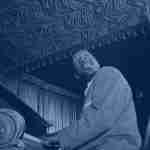Recorda Me is one of Joe Henderson’s most famous compositions. Recorded on his epic album Page One from 1963, he actually composed the popular jazz standard when he was only 15. And over the years, it’s become a mainstay in jazz education and jam sessions alike, making it a need-to-know tune to add to your repertoire.
Now Recorda Me, sometimes spelled Recorda-Me, Recordame, or Recuerdame, means “remember me” in Portuguese and for some reason, just like Maiden Voyage and Blue Bossa, it’s been lumped into the “Easy” jazz standard category – a tune that a beginner should be able to handle with little effort.
But as you know, what’s considered easy rarely is…
Recorda Me has several challenges to it including a unique form, original chords, and a Latin swing feel.
So today, we’ll get into the genius of Joe Henderson and how to play a great solo over Recorda Me. We’ll cover quite a bit…
- The chord changes and form of Recorda Me
- What makes the chord progression unique
- Various famous recordings of the tune
- A transcription of a Joe Henderson solo on Recorda Me
- And 5 key solo tactics that he uses to flow through the changes

Let’s dive into this beautiful tune…
Recorda Me Chord Changes & Form
One of the most important aspects of learning a tune is understanding the form, and most of time in jazz, a tune uses a common form like AABA or ABAB where sections of the tune repeat several times.
But Recorda Me is different…have a listen to the tune from Joe Henderson’s album Page One…
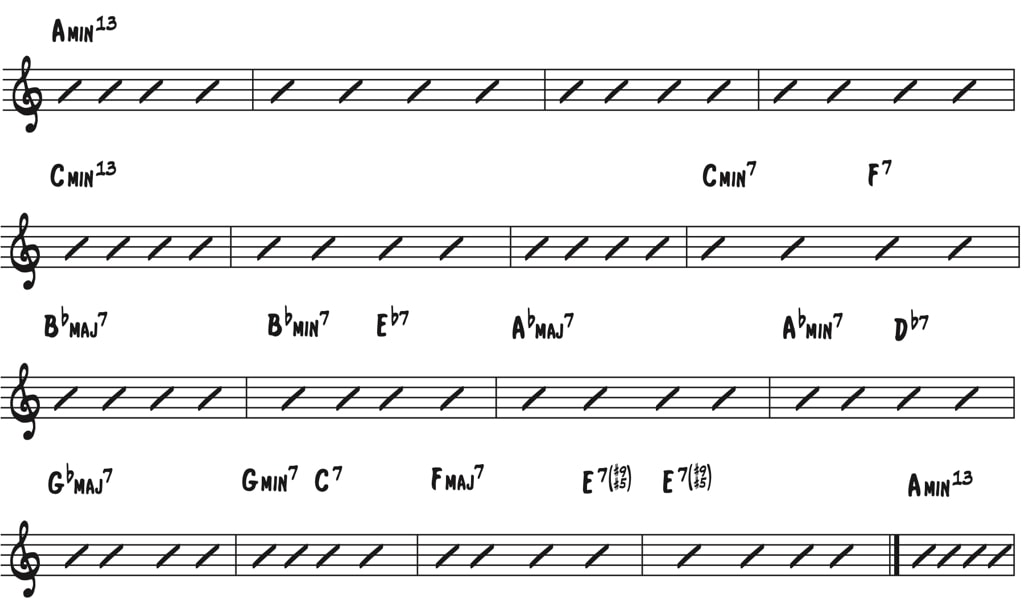
A total of 16 bars, each 4 measure piece of the tune is a new section, not repeating anything that came before it.
So the form of the tune might be referred to as through-composed (although the form itself repeats), or you might simply call it a tune with non-repeating sections.
Of course you could call each 4 bars a section and label it ABCD, or you could chunk the tune into 8 bar sections and call it AB, but what good does that do?
Most of the time knowing the form really helps you because a section repeats two or three times, but here, knowing the form doesn’t help that much because no section of it repeats.
So how might we think about the chord changes to Recorda Me?
Making sense of the changes
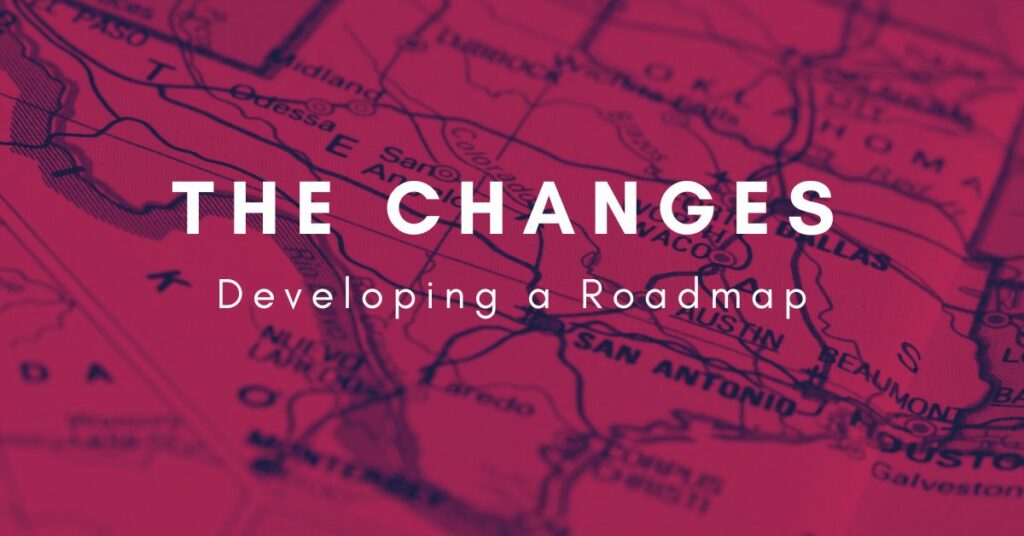
When it comes to the chord progression of Recorda Me, the first thing to note is the relationship between the first two chords – they’re a minor third apart.
You start with A minor followed by another minor chord up a minor 3rd, C Minor:

And then, this second minor chord, C minor, becomes the start of a ii V7 at the end of its 4 bar section, resolving to Bb major.
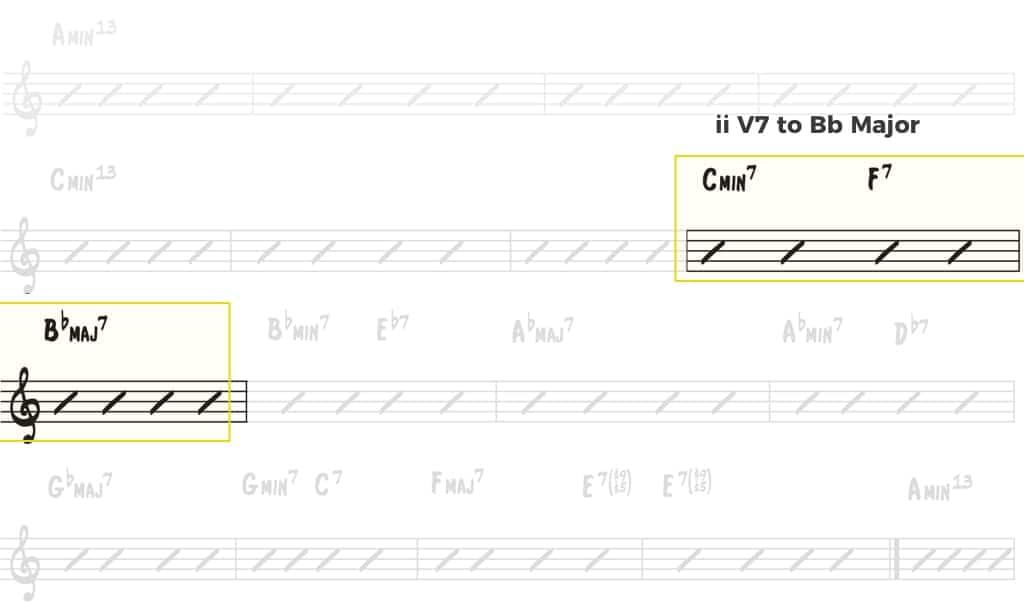
This ii V7 I then moves into a series of ii V7 Is that move the tonality down in whole steps – Bb Major, to Ab Major, to Gb Major…
And notice that to accomplish this downward whole step motion, the chord changes use the essential chord relationship of Major to Minor: Bb major moves to Bb minor…Ab Major moves to Ab minor…
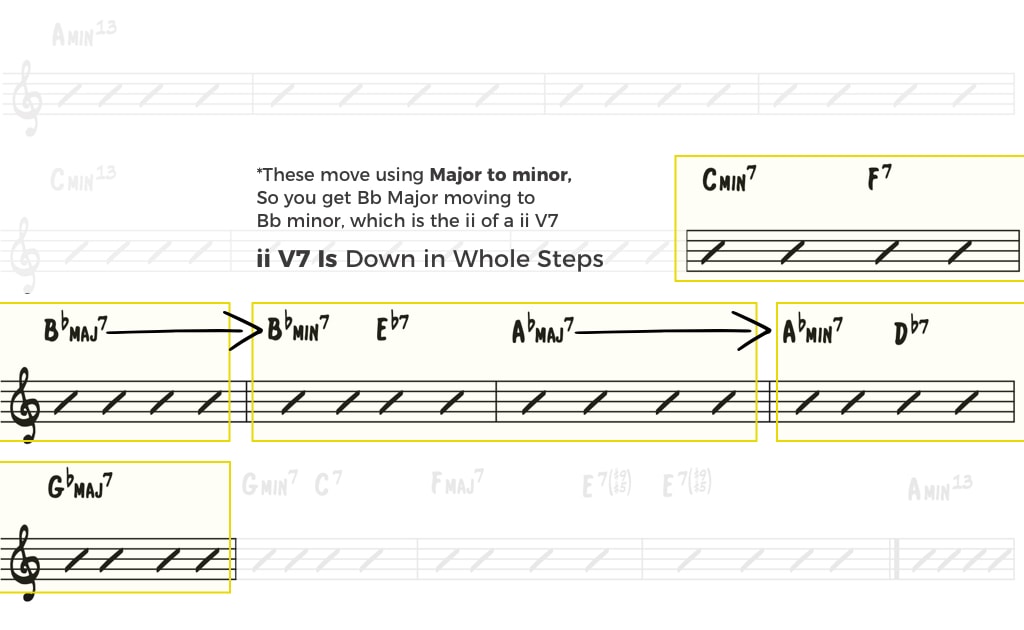
Finally, Joe changes it up by using a ii V7 that starts a half step above the previous chord (G minor is a half step above Gb Major)…
But this particular ii V7 actually moves us down a half step in tonality instead of a whole step, Gb major moving to F major. And then he follows this up with the V7 chord that moves back to A minor, the top of the form…
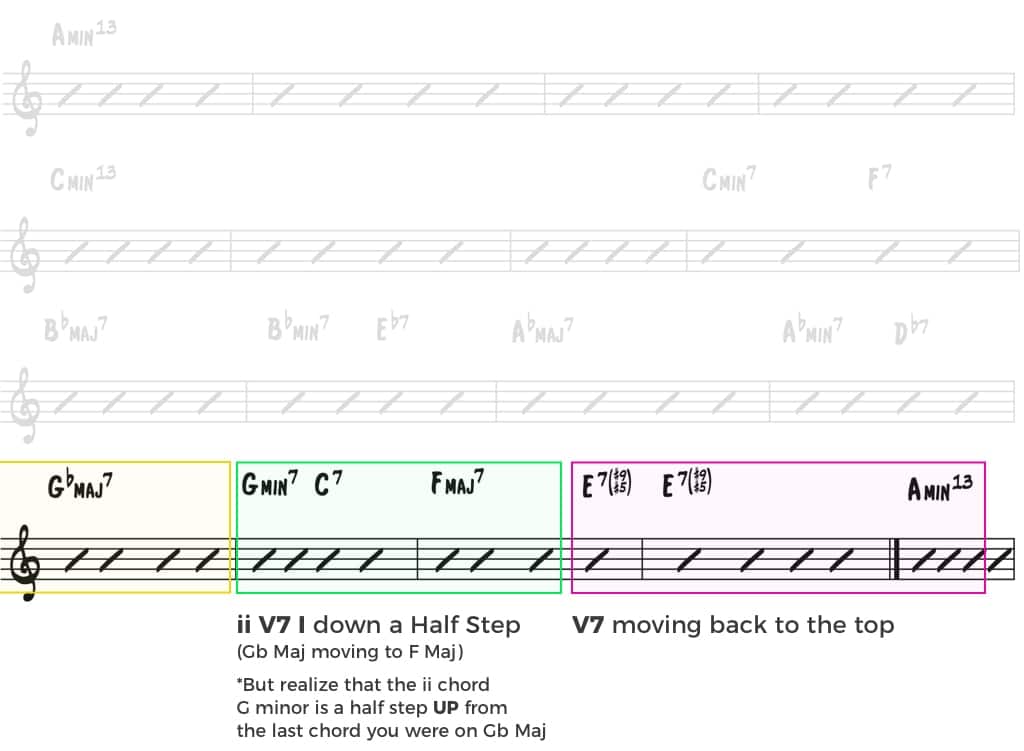
So to put it all together, we’ve got two minor chords a minor 3rd apart, then a series of ii V7 Is moving down in whole steps, followed by a ii V7 I that moves the tonality down a half step, and finally, we reach a V7 chord that pushes back to the top of the form.

And this is essentially how your ear likely hears these chords…
In other words, this tune probably sounds like it starts out in the key of A minor and then moves to the key of C min.
And then, it sounds like it moves through a series of ii V7 Is, eventually ending up at F major and moving to the V7 of A minor.
So, to think about this form in a single key is pretty tricky – your mental and aural road map for Recorda Me is probably fairly close to what I’ve described here but as always, feel free to put your own spin on it.
Okay, now that you have an idea of the changes, let’s talk about some of the different recordings of Recorda Me.
Researching Different Recordings
Any time you want to study a tune, it’s a good idea to check out multiple recordings, and the first recording, and probably the most famous recording of Recorda Me, is the one we already listened to a bit – Page One.
Here’s the full version below…
The next recording comes from Joe Henderson’s Live at The Lighthouse.
And finally, the last recording I want you to listen to is Joe Henderson’s big band arrangement of the tune, which is actually the one we’ll study today…
So why are we going to study this last one, after all, it’s not even a small group setting, but instead a big band?
Here’s the thing…
Joe Henderson does not always keep it simple, so finding a recording where he plays a bit more straight forward will allow you to hear his ideas & concepts more easily.
Remember, a player’s secrets are on ALL of their recordings. Sometimes it’s a whole lot easier to find a simpler version where you can really hear what’s going on.
And this is why I like his solo on the big band recording so much. It’s the perfect solo to transcribe to figure out how to play over Recorda Me.
Joe Henderson’s solo on Recorda Me

Today we’ll be looking at the first chorus of Joe Henderson’s solo on Recorda Me from his big band album, and it’s pure perfection.
Have a listen to the full chorus before we pull it apart…
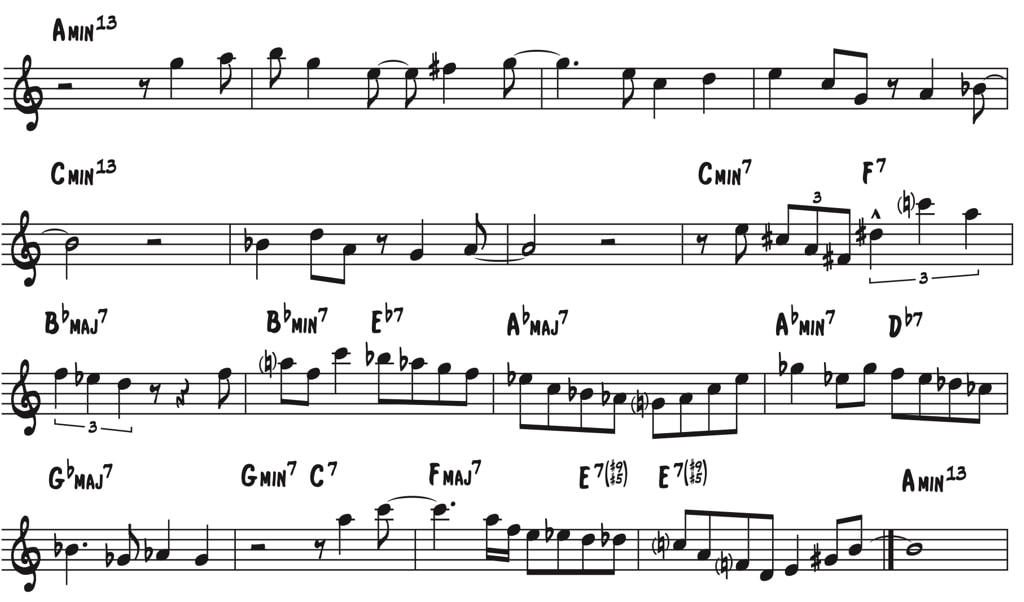
There is so much to learn from these 16 bars. Things like:
- How to practice minor sequences
- How to use upbeat rhythms in your lines
- How to use cells over minor 13 chords
- How and where to apply tritone subs
- How to make use of simple V7 resolutions
And quite a bit more! So let’s get into it…
5 Joe Henderson Soloing Tactics on Recorda Me
Joe Henderson is incredible…
And so much of what he plays sounds as though it’s not from this world, highly technical and complex, yet still melodic. So the difficulty in transcribing him always becomes, how can you actually make use of what you find?
I mean, getting the notes doesn’t really matter if you can’t take your findings into your own playing…
With Joe Henderson, you just have to take it slow and look at each line from multiple angles
What’s he doing melodically? Is he using a sequence or a certain group of notes? How about harmonically? What chords is he thinking of? The original ones, or some substitution?
And then there’s his rhythm…
His rhythm is at the heart of what makes his playing sound so amazing, so when studying Joe Henderson, always ask yourself, what kinds of rhythmic techniques is he using?
Okay, let’s get into the start of his solo, which opens with a minor sequence.
1. Make Your Sequences Rhythmic
When most people use sequences, they use them in a predictable way that sounds like a pre-built pattern, usually made up of primarily eighth notes…
But Joe Henderson likes to elongate his sequences and make them rhythmic, disguising them so much that you might miss that he’s using a sequence altogether.
Have a listen to this line and try to spot it.

Can you hear it?
If we remove the rhythm from the line, you can see that this line is based upon a minor sequence that goes through a simple shape, descending from each of the primary chord tones, 7-5-3-1.

Now, of course at the end of his line he morphs into the next chord, C minor

But, the idea behind the line comes from this simple minor sequence. So the first thing you might want to do is to practice this minor sequence in all keys, using eighth notes like this…

You can take it around The Cycle, in half steps, or anything you want, but just try to take it through all keys.
Then, a great exercise specifically for Recorda Me is to take the sequence through ascending minor 3rds because that movement simulates the chords of the tune.

Being able to easily move this sequence up in minor 3rds will greatly improve your facility with it.
Okay, now let’s talk about the rhythmic concept that Joe Henderson uses here because he uses this same tactic throughout his playing. Have a listen to the first piece…

The key here is so subtle yet most people don’t realize how effective this rhythmic technique is – place quarter notes on up beats.

That’s what he’s doing…
Rather than putting quarter notes consistently on strong downbeats, he purposely places them on the upbeat which gives his lines a great sense of forward motion.
And then here’s the second part of the line…

Notice that in the second part, he places the first few quarter notes on downbeats, and then switches to the upbeat again near the end…

Combine sequences with quarter notes on the up beat and the result is a strong melodic line that pushes forward over several measures, easy and effective.
2. Make Use of Cells…And Make Them Rhythmic Too!
I love thinking of Cells because they give you a small flexible melodic unit that you can easily apply to many harmonic situations.
Remember, a Cell is just a group of several notes, the most common being a 4-note-cell, and it’s not in the shape of a chord, that’s an arpeggio.
Instead it’s a group like 1235 or 1345 of a chord or scale – a simple digital pattern that’s easy to think about.
Now a very common way to use cells is to think about them from the 5th of a chord…you’ll see what I mean a minute.
But first let’s talk about the rhythm of this line here…

Sound familiar? It should because it’s the exact same rhythm as before…

So before we move on, remember, make everything rhythmic. Sequences, Cells, Scale Patterns, whatever…don’t go on autopilot with your rhythm, keep it interesting.
Alright, one thing that Joe wants to do over these minor chords is emphasize the natural 13th.
This upper extension really makes these chords sound like a home base, and defines them within the tune.
And you can see that he uses the 6th, same as the 13th, right here…

Well, getting back to our Cell – here he’s using what looks like the chord-tones 7-2-6-5 at first glance…

But a simpler way to think about this four-note-cell is as a 1235 Cell based from the 5th of the chord (G), that is then reordered into 3521.

This Cell type thinking can make it much easier to hear and have access to a group of chord-tones that otherwise might be out of your reach.
If you want to go further into Cell Practice & Exercises, make sure to check out our course Melodic Power. We have a whole section dedicated to powerful Cells and various ways to incorporate them into your playing.

3. Apply Tritone Subs in Pivotal Places
A Tritone Sub, substituting a dominant chord for another dominant chord that’s located a tritone away, is a common way to play outside the chord changes.
And it works because the 3rd and 7th of the original dominant chord (F7), are the 7th and 3rd of the substitution (B7).
Here you can see how the 3rds and 7ths are related, and how with the substitution, you gain a whole lot of interesting tension notes…
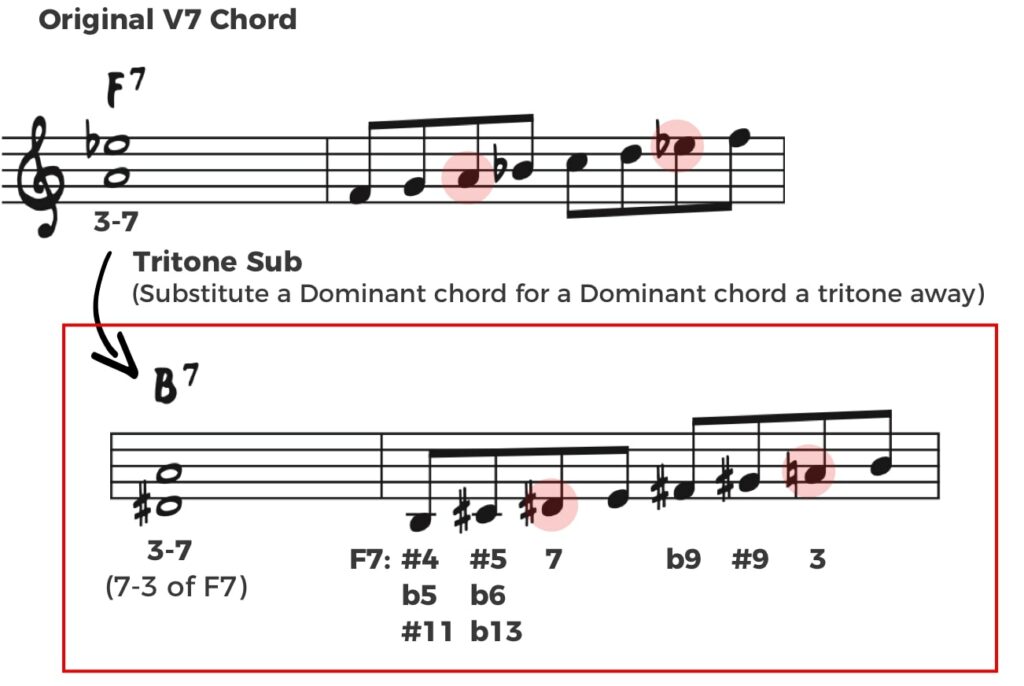
Now, of course, it’s a technique that Joe Henderson loves to use. Have a listen…

Can you hear that at this pivotal moment in the form as we’re moving to the first major chord of the tune, he adds quite a bit of tension?
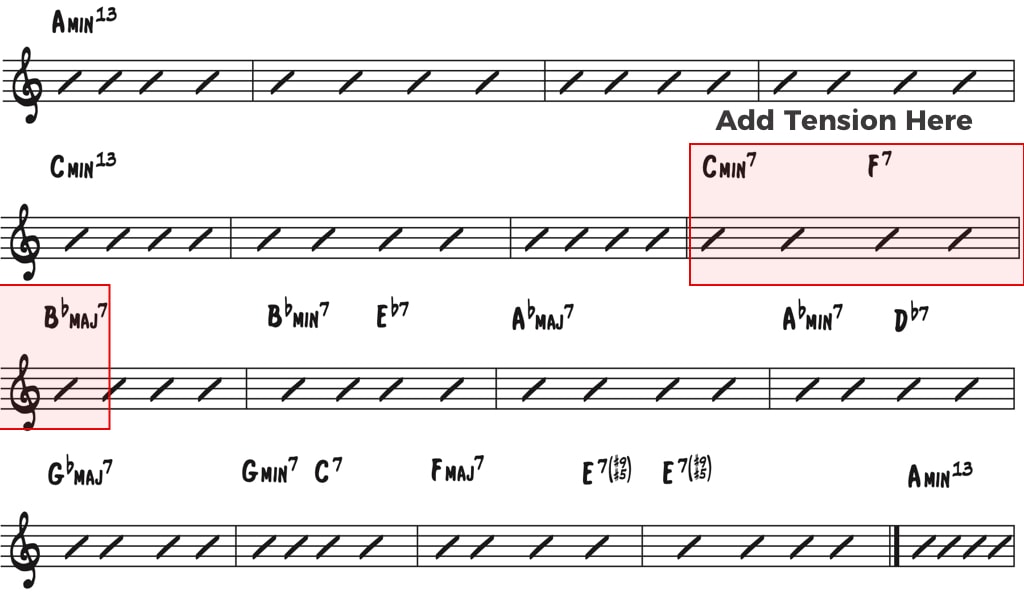
He does this by playing not just the dominant chord sub, but a full ii V7 located a tritone away from the original…
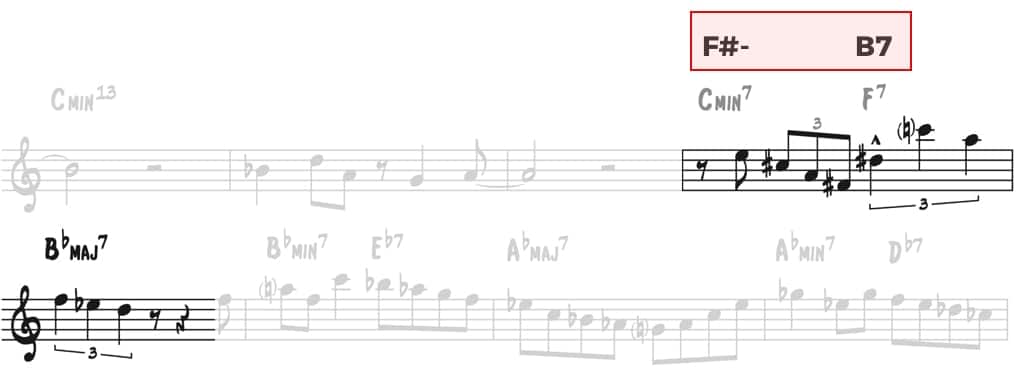
This full tritone sub ii V technique is one that’s super powerful but takes quite a bit of time to be able to hear and use…
And one of the easiest ways to start using it is to copy exactly what Joe is doing – He’s not overthinking it.
Rather than playing something crazy, he keeps his melodic line as simple as possible. He plays a standard bebop fragment, 7-5-3-1 of a ii minor chord moving to the 3rd of the V7 chord…

And that’s the key with substitutions. Keep it simple!
4. Use Simple V7 to I Resolutions & Highlight Major to Minor
Coming from Tritone Subs, you’d think that we’d have more complex concepts to get into today, but often the best players balance out their complexity with simple tools…
And one of these tools that you definitely don’t want to pass on is having an arsenal of simple V7 resolutions at your disposal.
Take a listen to this line, and try to hear how each piece of the line resolves so clearly…

Both dominant chords in the line , the Eb7 moving to Ab major, and the Db7 moving to Gb major, resolve by using very simple resolutions.
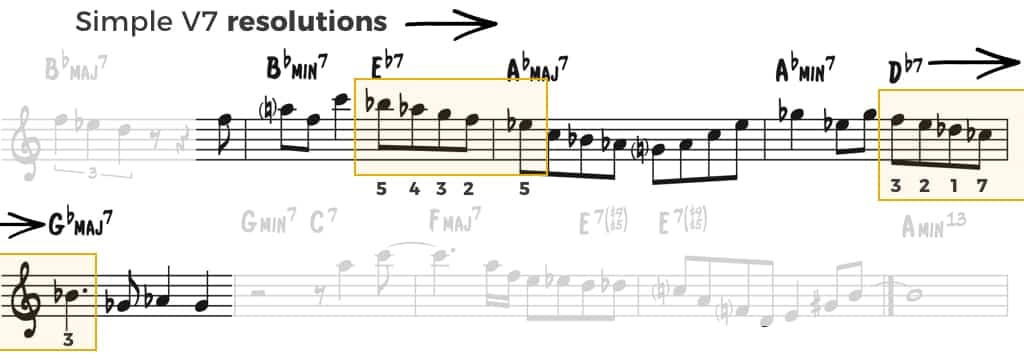
Practicing these little bits of information in all keys is a great exercise to gain fluidity with these resolutions.
First, start with the one on Eb7, 5-4-3-2, moving to the 5th of the major chord, taking the idea around The Cycle…
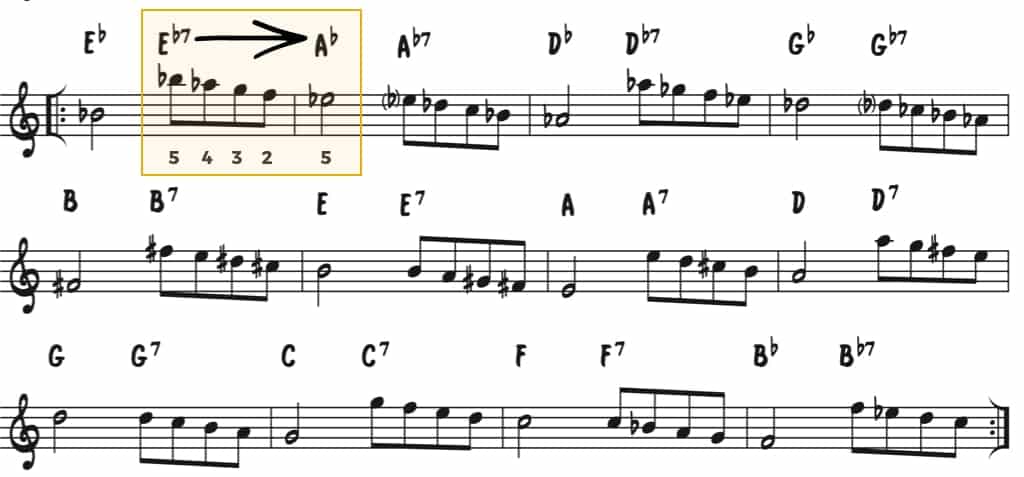
You can visualize the chords here as I wrote them with a resolving chord and then a dominant chord, or you can just think of the dominant chords.
And then, once you’re comfortable with that simple V7 resolution, try the one that Joe uses moving from Db7 to Gb major, taking it through all keys…
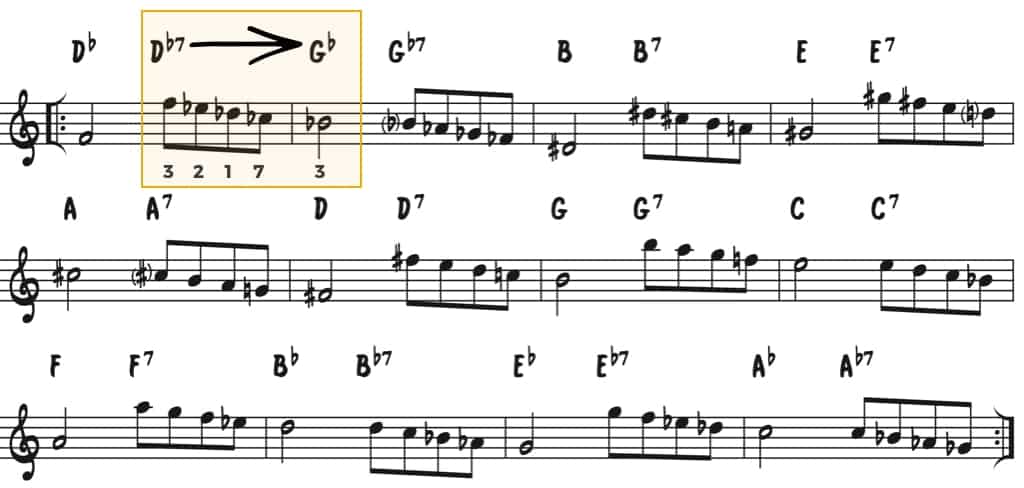
As you practice these, make sure to visualize the chords that you’re playing over and to not let your mind wander.
A big part of this type of practice is connecting your ears, mind, & fingers, so if you let your mind wander, you’re missing a crucial piece of the puzzle.
Okay, next let’s zoom in on the part of the line where the chords move from major to minor – at this point in the form, it’s really clear that Joe wants to highlight this change in quality.
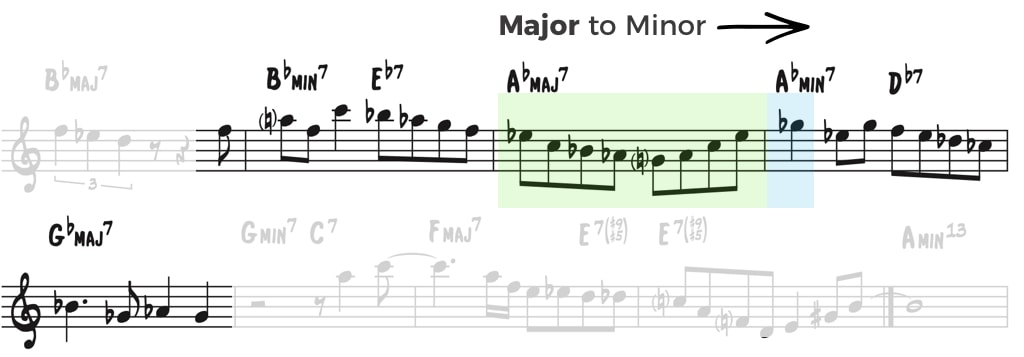
Like the simple V7 resolutions, this is something you can practice with an easy exercise, moving a line or improvising over chords that are moving from major to minor, down in whole steps (Ab is moving to Gb, a whole step)…
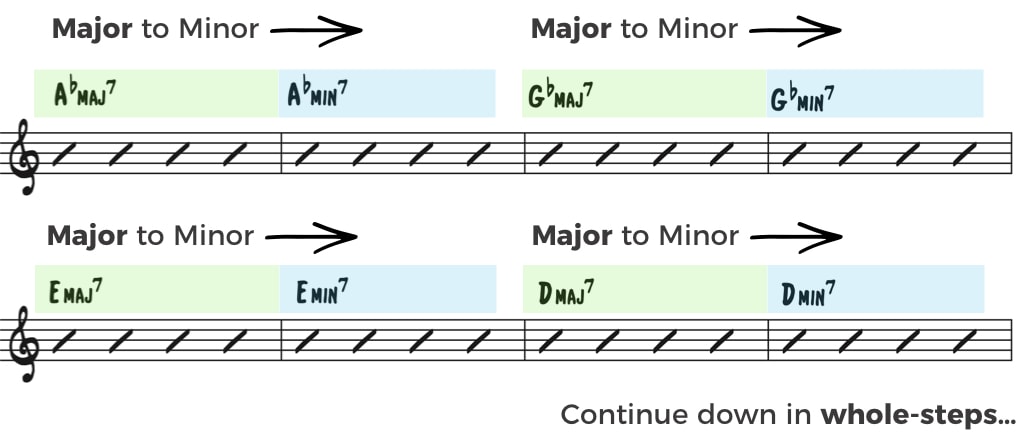
And using Joe’s line as a starting place, would look like this…
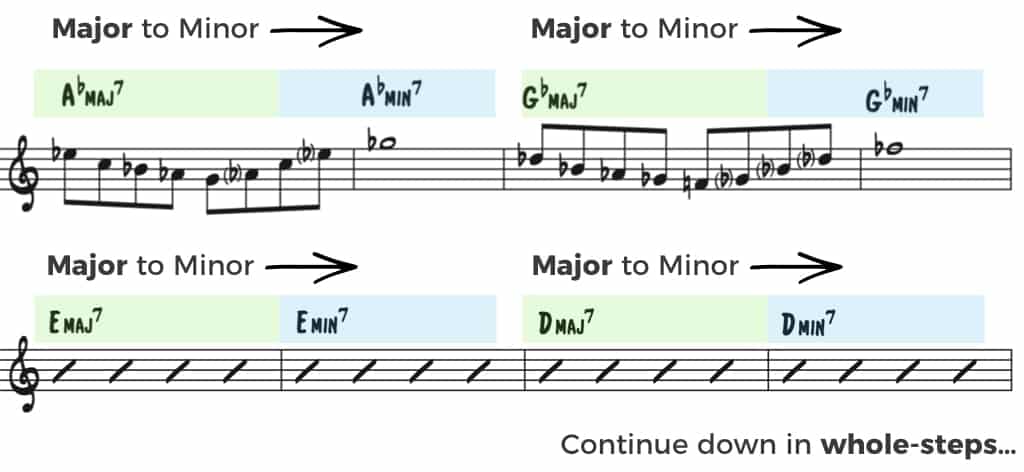
This is a great exercise to start mastering major to minor so take your time with it and focus on hearing the change in quality as you move from one chord to the next.
5. Realize That Some Chords Are Closer Than You Think
One final Joe Henderson improvisation tactic we’re going to look at today has to do with how two seemingly unrelated chords are actually more similar than you might think…
You see, many chords that we may encounter in a tune seem totally unrelated.
But in reality, there’s always some sort of a connection, and the more you know about jazz harmony, the easier it is to see, hear, and understand these connections…and the changes to Recorda Me are no exception.
These last two chords, F major moving to an altered E7 sound are actually a whole lot closer in their construction than you may have realized.
Take a listen to what Joe Henderson plays over these final bars…

Did you notice that there’s not much change in his melodic concept moving between these two bars?
If you look at basic chord voicings and scales of these chords, it makes perfect sense why Joe can easily transition between them with not much change because there’s actually only a single note different…

So keep in mind that you don’t need to change a whole lot as you transition between these two chords, and that your F major line will flow perfectly into E7alt…

This is a great tactic to move smoothly between these chords and to create a strong melodic line that continues clearly through the end of the changes.
Steps to Master Recorda Me
So there you have it…
While Recorda Me may be presented as a beginner jazz tune in today’s world, it has quite a few challenges. But if you use this checklist, you’re sure to master it in no time.
Here are the steps to master Joe Henderson’s Recorda Me:
- Start by understanding the unique form
- Get a mental model of the chords & understand the logic behind them
- Research some different recordings
- Study Joe Henderson’s solo on Recorda Me
- Integrate his solo tactics into your own playing
And remember to…
- Be Rhythmic! – Apply interesting rhythms to everything you’re playing
- Use Melodic Sequences & Cells – Forget the scales for a minute and add some variety to your melodic approach
- Apply Tritone Subs at Pivotal Spots – Don’t just use chord subs aimlessly, put them in the spots that matter
- Get some simple resolutions & Major to Minor Ideas – Practicing the simple exercises we went over today will do wonders for your playing.
- Realize that Unrelated Chords Might be Similar – When you truly understand a chord, you’ll find that everything makes sense, and that two seemingly unrelated chords are a whole lot closer than you think.
Recorda Me is a beautiful tune and it’s popular in many jam sessions and player circles, so take everything we shared with you today and start practicing it.
Take your time studying the great Joe Henderson and all he has to offer and you’ll take your melodic, harmonic, and certainly your rhythmic understanding to a whole new level.









